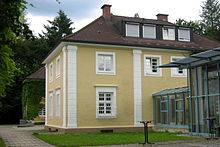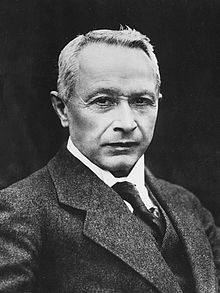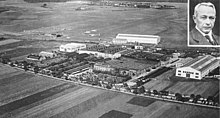Hugo Junkers

Hugo Junkers (born February 3, 1859 in Rheydt ; † February 3, 1935 in Gauting ) was a German engineer and entrepreneur .
He founded in 1895 in Dessau , the company Junkers & Co. and was until 1932 the owner of the Junkers engine GmbH and Junkers aircraft factory AG . Initially known as a designer of gas boilers , Junkers developed fundamental knowledge in aircraft construction, such as all-metal construction and corrugated structure, as a university lecturer and researcher, engineer and entrepreneur. In addition, his group also manufactured aircraft engines. He founded the airline Junkers Luftverkehr AG , which in 1926 because of considerable financial difficulties and pressure from the Reich government with the German Aero Lloyd to the air Hansamerged. As a result of the global economic crisis , the plants ran into financial difficulties in 1932. Since he stood in the way of the National Socialists as a democrat and pacifist , he was expropriated in 1933 and was banned from the city of Dessau. He was forced, ostensibly to turn to scientific research, to give up the management of his works and to retire to Bayrischzell in Bavaria. Two years later he died on his 76th birthday and was buried in the forest cemetery in Munich . In memory of Hugo Junkers, the state of Saxony-Anhalt awards the Hugo Junkers Prize for research and innovation from Saxony-Anhalt every year .
Life
childhood and education
Hugo Junkers came from a wealthy family that offered him and his siblings very good educational opportunities and financial independence. He was the third of seven children of the entrepreneur and owner of a cotton weaving mill Heinrich Junkers and his wife Luise. After attending the higher citizen school (today: Hugo-Junkers-Gymnasium ) from 1864 to 1875 in Rheydt, he then switched to the trade school in Barmen , where he graduated from high school in 1878. After an internship in the Karl Klingelhoefer machine tool factory , Junkers began studying at the Royal Trade School in Berlin in September of the same year , which became part of the Technical University of Charlottenburg in 1879. After two semesters, he continued his studies at the Technical University in Aachen from October 1881 and graduated there in 1883 with an examination in mechanical engineering. During his studies he became a member of the Turnerschaft Rhenania Berlin (today Turnerschaft Berlin zu Berlin) and the Corps Delta Aachen.
After initial professional experience in various companies in Aachen and in his father's company in Rheydt, for which he temporarily interrupted his studies, Junkers returned to the Technical University of Charlottenburg to listen to Adolf Slaby's further lectures in electrodynamics and thermodynamics and in his Electrotechnical laboratory to carry out mechanical tests.
Entrepreneur
In 1888, through the mediation of Slaby, Junkers went to Dessau to the Deutsche Continental Gasgesellschaft , which had started producing electricity two years earlier and also developed the corresponding engines. Together with the technical director, Wilhelm von Oechelhäuser jun. , Junkers developed new engines; Both succeeded in developing the first two-stroke opposed piston gas engine in 1892 .
Since knowledge of the calorific value of the gas used is crucial for the operation of the engine, Junkers simultaneously developed a calorimeter , which was registered for a patent on June 29, 1892 . In October of the same year, Hugo Junkers founded his first company, Hugo Junkers, civil engineer, and started working in a horse stable rented by the gas company. The first employee was the master plumber Otto Knick (1865-1921), later manager of Junkers & Co.
The calorimeter, which measures the temperature difference in the heated water, was presented to the general public at the 1893 World's Fair in Chicago, where it was awarded a gold medal. Junkers himself stayed in the USA and presented the device together with Paul Sachsenberg from the Sachsenberg works in Roßlau .
Using the same technical principle, Junkers applied for a patent for his first gas bath heater in 1894 and developed it further into a flow heater . For the economic evaluation of his patents, Junkers founded the company Junkers & Co. on July 2, 1895 together with Paul Ludwig as investor and one year later they moved into a newly built company building in Dessauer Albrechtstrasse. Calorimeters, household appliances (“Junkers thermal baths”) and gas pressure regulators were manufactured there.
As early as 1897, Junkers also accepted a position as professor of thermodynamics at the Technical University of Aachen after he had paid off his partner Ludwig. He handed over the management to Hermann Schleissing and founded the research institute Professor Junkers in Aachen in order to promote research in addition to his teaching activities. He financed this from the surpluses of Junkers & Co. First, Junkers turned back to engine construction and registered some patents for heavy oil engines.
On March 31, 1898, Junkers married the Dessau bourgeois daughter Therese Bennhold (1876–1950). The marriage resulted in 12 children.
From 1901 onwards, further research into heat transfer resulted in patents, which Junkers exploited economically from 1904 in the calorifiers department at Junkers & Co with the manufacture of fan heaters .
Aircraft, engine builders and air shipping companies
From 1908 Junkers worked in Aachen with Hans Reissner , who directed Junkers' field of vision to aerodynamics and aircraft construction . A year later, Reissner's prototype took off on a test flight, the wings of which had still been manufactured in the Junkers & Co. gas equipment factory in Dessau. They were wings made of metal.
In 1910, Junkers applied for a patent for the cantilevered , unrestrained wing with a thick profile , his first patent in aircraft construction, which was trend-setting for all of flight technology . On the initiative of Junkers, a wind tunnel was also built in Aachen in 1910 . Almost on the side, Junkers designed the first water vortex brake around this time .
Junkers returned to Dessau in 1912 and opened an engine factory in Magdeburg the following year ; it was closed again in 1915.
The first all-metal aircraft, the J 1, was developed in 1915 . From 1917 to 1919 the company merged with Fokker to form Junkers-Fokkerwerke AG. During the First World War , this company was an important armaments company, but only a few aircraft developed there were ready for the front.
In 1926, at the urging of the Reich Ministry of Transport , his airline Junkers Luftverkehr AG was merged with Deutsche Aero Lloyd to form Deutsche Luft Hansa , because both shipping companies were individually uneconomical without subsidies. The initiative in the Reich government came essentially from Ernst Brandenburg .
Junker's endeavors after the First World War up to his retirement in 1933 were mainly focused on civil aviation, which he promoted and shaped as an aircraft and engine manufacturer as well as air shipping company. The aircraft types Junkers F 13 , the G 38 and the Ju 52 / 3m became famous . Junkers competed with Dornier for the better concept for long-haul flights across the Atlantic (see also Atlantic crossing ). Junkers' favorite land planes; Dornier seaplanes . The much younger Dornier (1884–1969) offered Junkers a collaboration; Junkers refused.
After Junkers Motorenbau GmbH , which Hugo Junkers had re-established in Dessau in 1923, ran into financial difficulties at the beginning of 1930 against the backdrop of the global economic crisis , Junkers had to file for bankruptcy for his entire group of companies on March 22, 1932 . On November 4, 1932, Robert Bosch AG took over Junkers & Co. for 2.6 million Reichsmarks, thereby enabling Hugo Junkers to end the settlement negotiations in his favor on November 8, 1932 . By selling his gas equipment factory, Hugo Junkers was initially able to protect aircraft and engine construction from unauthorized access.
expropriation
Shortly after the takeover of the Nazi regime on January 30, 1933, for the new "Reich Commissioner for aviation," Hermann Goering , whose employment Junkers ten years had previously rejected, the Junkers engine GmbH and the Junkers aircraft factory AG to the object of rearmament policy pursued by him . Under great pressure, Hugo Junkers had to surrender the majority of the rest of the group to the German Reich in 1933 . Junkers was banned from the house and city and had to leave Dessau.
After the expropriation until his death, Junkers devoted himself entirely to metal construction, another area of interest that arose during his time in Dessau. Inspired by the neighborhood and cooperation with the Bauhaus , Junkers created theoretical plans for metal architecture. The lamellar structures of its spacious hangars were developed from these considerations . This construction , which goes back to Friedrich Zollinger , was then exported for halls in over 27 countries . A model metal house can be seen today in the Hugo Junkers Technology Museum in Dessau-Roßlau .
The companies were merged in 1936 to form Junkers Flugzeug- und Motorenwerke AG . The aircraft later used in the war from 1939 - such as the Ju 87 or Ju 88 - were built under state control; With their smooth hull construction, they had nothing in common with the Junkers design and cannot be attributed to him.
Professional activity
- 1892 First Hugo Junkers Civil Engineer company in Dessau and patent for the calorimeter
- 1895 Foundation of the Junkers & Co. company in Dessau, partner is Ludwig, who leaves in 1897
- 1897 Foundation of the research institute Prof. Junkers in Aachen
- 1902 Establishment of the research institute for oil engines in Aachen
- 1913 Junkers Motorenbau founded in Magdeburg, closed in 1915
- 1914 Founding of the Hugo Junkers calorific factory in Dessau
- 1915 Foundation of the research institute Prof. Junkers in Dessau with takeover of the research institute in Aachen (1919)
- 1915 Development of the first all-metal aircraft ( J1 )
- 1916 Foundation of the main office Junkers Werke in Dessau
- 1917 Company merger to form Junkers-Fokkerwerke AG , dissolved again in 1919
- 1919 Foundation of Junkers Flugzeugwerke AG (Ifa) in Dessau
- 1919 Construction of the first civilian all-metal aircraft F13
- 1919 Creation of the lamella calorifer department within Junkers & Co.
- 1921 Formation of the steel construction department within the Hugo Junkers calorific factory
- 1921 Foundation of Junkers Luftbild within the Ifa
- 1921 Founding of the air traffic department within Ifa (later part of Luft Hansa)
- 1923 Foundation of Junkers Motorenbau GmbH (Jumo) in Dessau
- 1924 Foundation of Junkers Luftverkehr AG , restructuring the aviation department
- 1925 Foundation of the Junkers Aviation School
- 1925 The pest control department is set up within the Ifa
- 1927 Formation of the central training workshop in Dessau
- 1927 Awarded the Wilhelm Exner Medal
- 1927 Awarded the Grashof Memorial Medal from the Association of German Engineers
- 1928
- First east-west crossing of the Atlantic with a Junkers W 33 by Hermann Köhl , Ehrenfried Günther Freiherr von Hünefeld and James Fitzmaurice
- Awarded honorary citizenship of the city of Rheydt
- Awarded honorary citizenship of the city of Aachen
- Appointment as honorary citizen of the RWTH Aachen
- Appointment as honorary senator of the RWTH Aachen
- 1930 Foundation of the company for Junkers Diesel-Kraftmaschinen mbH in Chemnitz
- 1930 Junkers receives the Siemens ring
- 1930 The Junkers Betriebs GmbH holding company is formed
- 1930 Completion of the Ju 52 / 1m (one engine)
- 1932 Completion of the G 38
- 1932 Completion of the Ju 60
- 1933 Construction of the Ju 52 / 3m (three engines)
- In 1933 Junkers was forced to surrender his patents and the majority of 51% of the shares in Junkers Flugzeugwerke AG to the German Reich without compensation ; he is pushed out of his company. The National Socialists classify Junkers as not reliable for them. Other sources speak of a settlement by Hermann Göring , who is said to have applied as a test pilot earlier and was not hired by Junkers.
- 1933 Junkers moves to Bayrischzell , to a house that was the family's vacation home, and is there under arrest and observation by the authorities.
- From 1933 to 1935 Hugo Junkers dealt with metal house construction, one of his earlier research interests. That is why he founded the “Research Institute Professor Hugo Junkers GmbH” in Munich. He took care of the rational and functional equipment of these metal houses, of air conditioning, mobilia and inexpensive room lighting in his research. Junkers tried to limit himself to a few different components that were easy to design and, thanks to their shape, had a timeless aesthetic. His metal house constructions, especially the roofs, are made in a form in which “the technology can also be perceived as beautiful”. Even during his time in Dessau, Hugo Junkers maintained contact with the artists of the Dessau Bauhaus , from whom he received suggestions for his work, but on which he also exerted influence himself. The buildings developed by Junkers can be found in more than twenty countries and are still doing their job today after more than 70 years.
Shortly after his death, his widow sold the 49 percent of Junkers' silent shares in the works to the German Reich for 30 million Reichsmarks. From 1935 the Junkers Flugzeugwerke AG including the associated companies were a state enterprise of the German Reich. During the Second World War, the Junkers factories became one of the most important German manufacturers of military aircraft. During this period, however, the works were no longer owned by Junkers or his descendants.
museum
Hugo Junkers is honored today in Dessau, the city of his work, with the Hugo Junkers Technology Museum . The museum's exhibits include a restored Ju 52 (also known as "Tante Ju"), a Junkers steel house and many other exhibits from Junkers' extensive creative field.
See also
literature
- Hugo Junkers: exhaust pipes to Junkers. Instructions for the correct execution of the flue pipe for gas appliances - For use by gas professionals, plumbers and architects. 3. Edition. Self-published, Dessau 1931, DNB 574181318 .
- Gert Behrsing: Junkers, Hugo. In: New German Biography (NDB). Volume 10, Duncker & Humblot, Berlin 1974, ISBN 3-428-00191-5 , pp. 695-697 ( digitized version ).
- Olaf Groehler : Hugo Junkers - legend and reality. In: Wolfgang Sellenthin (Ed.): Fliegerkalender der DDR 1985. Military Publishing House of the GDR, Berlin 1984, pp. 88–99.
- Olaf Groehler, Helmut Erfurth: Hugo Junkers. A political essay. (= Military history sketches ). Military publishing house of the GDR, Berlin 1989, ISBN 3-327-00677-6 .
- Rainer Haus, Hans Sarkowicz: Using energy more efficiently. 75 years of Bosch thermal technology. Product information. Piper Verlag, Munich / Zurich 2007, ISBN 978-3-492-05084-5 .
- Hans Georg Hiller von Gaertringen (Ed.): Junkers Dessau. Photography and advertising graphics 1892–1933. Steidl Verlag, Göttingen 2010, ISBN 978-3-86521-887-2 .
- Günter Schmitt, Thomas Hofmann, Angelika Hofmann: Junkers and his planes. 2nd Edition. Transpress VEB Verlag for Transport, Berlin 1986, ISBN 3-344-00192-2 . (West German edition: Hugo Junkers and his aircraft. Motorbuch Verlag, Stuttgart 1986, ISBN 3-613-01111-5 )
- Günter Schmitt, Werner Schwipps: Pioneers of early aviation. Gondrom Verlag, Bindlach 1995, ISBN 3-8112-1189-7 .
- Manfred Sundermann (Ed.): Junkers. Dessau - mechanical city? Anhalt Edition, Dessau 2002, ISBN 3-936383-06-5 .
- Wolfgang Wagner: Hugo Junkers aviation pioneer - his aircraft. (= German aviation. Volume 24). Bernard & Graefe Verlag, Bonn 1996, ISBN 3-7637-6112-8 .
- Brian Walters (Ed.): Junkers: an aviation pioneer. (= Pictures of aviation ). Sutton, Erfurt 2000, ISBN 3-89702-235-4 .
- Junkers, Hugo. In: Robert Volz: Reich manual of the German society . The handbook of personalities in words and pictures. Volume 1: A-K. Deutscher Wirtschaftsverlag, Berlin 1930, DNB 453960286 , p. 863.
- Walter Scheiffele: The light house. Utopia and reality of membrane architecture. Leipzig 2016, ISBN 978-3-944669-45-8 .
Web links
- junkers.de - Life and work of Hugo Junkers (by Bernd Junkers, grandson of Hugo Junkers)
- Ulrike Triebs: Hugo Junkers. Tabular curriculum vitae in the LeMO ( DHM and HdG )
- Literature by and about Hugo Junkers in the catalog of the German National Library
- Newspaper article about Hugo Junkers in the 20th century press kit of the ZBW - Leibniz Information Center for Economics .
- Technology museum "Hugo Junkers" Dessau
- Grave of Hugo Junkers in the forest cemetery in Munich
- Entry about Hugo Junkers in the database of the Wilhelm Exner Medal Foundation .
Individual evidence
- ↑ mdr.de: The life of the aviation pioneer Hugo Junkers - a timeline | MDR.DE. Retrieved March 27, 2020 .
- ↑ Ludwig Bölkow (ed.): A century of airplanes: History and technology of flying. VDI, Düsseldorf 1990, ISBN 3-642-95776-5 , p. 26.
- ↑ Hugo Junkers accessed on July 1, 2020 in Wilhelmexner.org
| personal data | |
|---|---|
| SURNAME | Junkers, Hugo |
| BRIEF DESCRIPTION | German engineer and entrepreneur |
| DATE OF BIRTH | February 3, 1859 |
| PLACE OF BIRTH | Rheydt , North Rhine-Westphalia |
| DATE OF DEATH | February 3, 1935 |
| Place of death | Gauting , Bavaria |



